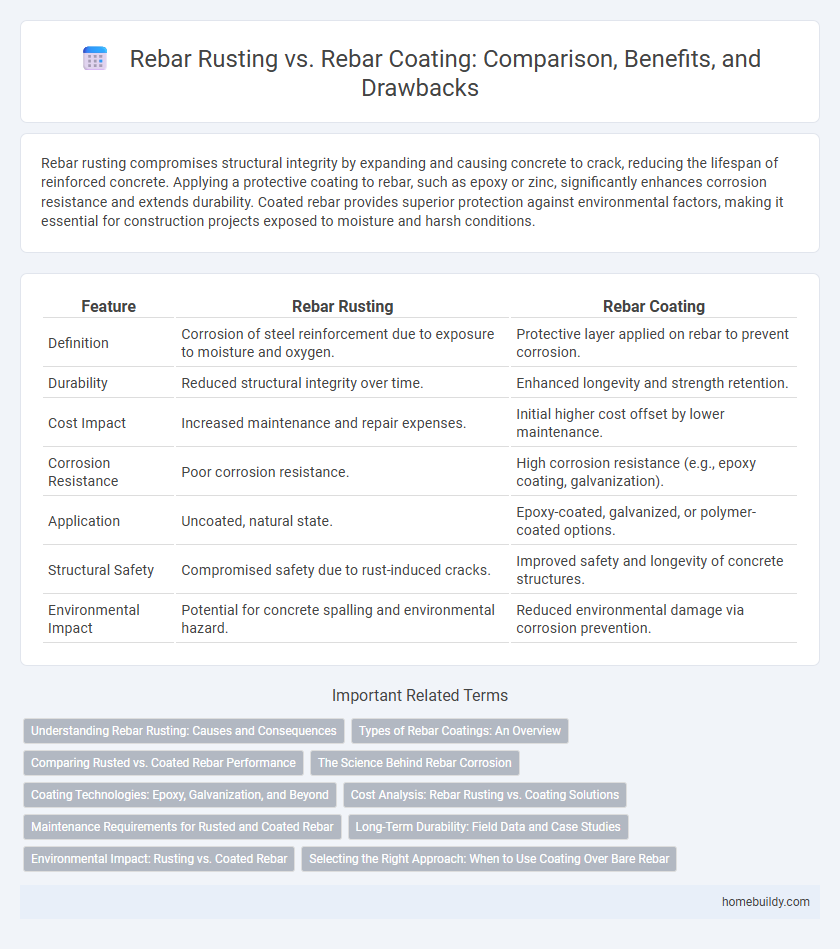Rebar rusting compromises structural integrity by expanding and causing concrete to crack, reducing the lifespan of reinforced concrete. Applying a protective coating to rebar, such as epoxy or zinc, significantly enhances corrosion resistance and extends durability. Coated rebar provides superior protection against environmental factors, making it essential for construction projects exposed to moisture and harsh conditions.
Table of Comparison
| Feature | Rebar Rusting | Rebar Coating |
|---|---|---|
| Definition | Corrosion of steel reinforcement due to exposure to moisture and oxygen. | Protective layer applied on rebar to prevent corrosion. |
| Durability | Reduced structural integrity over time. | Enhanced longevity and strength retention. |
| Cost Impact | Increased maintenance and repair expenses. | Initial higher cost offset by lower maintenance. |
| Corrosion Resistance | Poor corrosion resistance. | High corrosion resistance (e.g., epoxy coating, galvanization). |
| Application | Uncoated, natural state. | Epoxy-coated, galvanized, or polymer-coated options. |
| Structural Safety | Compromised safety due to rust-induced cracks. | Improved safety and longevity of concrete structures. |
| Environmental Impact | Potential for concrete spalling and environmental hazard. | Reduced environmental damage via corrosion prevention. |
Understanding Rebar Rusting: Causes and Consequences
Rebar rusting occurs when steel reinforcement bars are exposed to moisture and oxygen, leading to the formation of iron oxide that compromises structural integrity. Corrosion causes expansion of rust, resulting in cracking and spalling of concrete, which reduces load-bearing capacity and durability. Understanding rebar rusting is crucial for implementing effective corrosion protection methods such as epoxy coating or galvanization to extend the lifespan of concrete structures.
Types of Rebar Coatings: An Overview
Rebar coatings are essential for preventing corrosion and enhancing the durability of concrete structures by providing a protective barrier against rust. Common types of rebar coatings include epoxy coating, which offers excellent resistance to moisture and chemicals; galvanized coating, which uses a layer of zinc to protect against rust; and stainless steel rebar that inherently resists corrosion due to its alloy composition. Each coating type varies in cost, application method, and effectiveness, making the selection dependent on environmental exposure and structural requirements.
Comparing Rusted vs. Coated Rebar Performance
Rusted rebar significantly reduces the structural integrity of concrete due to corrosion-induced expansion, leading to cracking and spalling, whereas coated rebar, such as epoxy-coated or galvanized types, effectively resists corrosion and prolongs the lifespan of reinforced concrete structures. The performance of coated rebar includes enhanced durability and reduced maintenance costs, making it a superior choice for environments exposed to moisture and salts. In comparison, rusted rebar compromises tensile strength and bonding with concrete, resulting in premature structural failure and increased repair expenses.
The Science Behind Rebar Corrosion
Rebar corrosion occurs primarily due to the electrochemical reaction between iron in the steel and oxygen and moisture in the environment, which leads to rust formation that compromises structural integrity. Uncoated rebar is highly susceptible to this oxidation process, while epoxy-coated rebar provides a protective barrier that significantly reduces the penetration of chlorides and moisture, slowing the corrosion rate. The science behind rebar corrosion involves anodic dissolution of iron and cathodic oxygen reduction, where the coating acts as a physical and chemical shield to maintain the steel's durability in concrete structures.
Coating Technologies: Epoxy, Galvanization, and Beyond
Rebar coating technologies such as epoxy resin, galvanization, and advanced hybrid coatings significantly enhance corrosion resistance, extending concrete structure durability by preventing rust formation. Epoxy coatings offer a non-conductive barrier ideal for marine and high-chloride environments, while galvanized rebar provides a sacrificial zinc layer that corrodes preferentially, protecting the steel substrate. Emerging coatings combine nano-materials and polymer blends to improve adhesion, mechanical performance, and long-term corrosion protection beyond traditional methods.
Cost Analysis: Rebar Rusting vs. Coating Solutions
Rebar rusting leads to structural damage requiring extensive repairs, significantly increasing lifecycle costs compared to coated rebar solutions. Coating options such as epoxy or galvanization add initial expenses but reduce corrosion-related maintenance and extend service life. Long-term cost analysis favors coated rebar for infrastructure projects exposed to moisture or aggressive environments due to lower total ownership costs.
Maintenance Requirements for Rusted and Coated Rebar
Rusted rebar requires more frequent inspections and potential treatments to prevent structural degradation caused by corrosion, significantly increasing maintenance efforts and costs over time. Coated rebar, such as epoxy-coated or galvanized types, offers enhanced protection against moisture and chemical exposure, reducing corrosion rates and thus lowering maintenance frequency and expenses. Proper maintenance of coated rebar involves regular monitoring for coating damage to ensure long-term structural integrity and performance.
Long-Term Durability: Field Data and Case Studies
Rebar rusting significantly reduces the structural integrity of concrete, leading to costly repairs and shortened lifespan, as demonstrated by numerous field studies showing up to 30% strength loss within 10 years under corrosive conditions. In contrast, coated rebar, such as epoxy or galvanized variants, consistently exhibits enhanced long-term durability, with case studies reporting over 50 years of corrosion resistance and improved load-bearing capacity in marine and industrial environments. Field data underscores that using coated rebar reduces maintenance costs by up to 40%, ensuring sustainable reinforcement performance in aggressive exposure scenarios.
Environmental Impact: Rusting vs. Coated Rebar
Rusting rebar accelerates concrete degradation as corrosion expands, leading to structural damage and increased carbon footprint from frequent repairs and replacements. Coated rebar, such as epoxy or galvanized, inhibits rust formation, significantly extending the lifespan of concrete structures and reducing environmental waste. Utilizing coated rebar results in lower resource consumption and decreased greenhouse gas emissions over the infrastructure's lifecycle.
Selecting the Right Approach: When to Use Coating Over Bare Rebar
Selecting the right approach between rebar rusting and rebar coating depends on the environmental exposure and structural longevity requirements. Coating is preferred in aggressive conditions such as marine environments or areas with high chloride exposure, where bare rebar is prone to accelerated corrosion. Using epoxy-coated or galvanized rebar significantly enhances durability and reduces maintenance by preventing rust formation compared to uncoated rebar.
Rebar Rusting vs Rebar Coating Infographic

 homebuildy.com
homebuildy.com